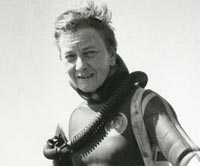 Honor Frost had many talents – as artist, ballet designer, scholar, writer and publicist, to name a few – but her consuming passion was the world beneath the oceans. Honor, who has died aged 92, initiated underwater archaeology as a serious field for study, and pioneered its pursuit as a scientific discipline.
Honor Frost had many talents – as artist, ballet designer, scholar, writer and publicist, to name a few – but her consuming passion was the world beneath the oceans. Honor, who has died aged 92, initiated underwater archaeology as a serious field for study, and pioneered its pursuit as a scientific discipline.
In the 1950s, she was the first diver to realise that it was essential not only to record shipwrecks of particular historical interest photographically, but also to represent them in meticulously detailed plans. From a modest start in 1956 on a wreck off the south coast of Turkey, she developed her technique throughout the Mediterranean. She organised the spectacular excavation and reconstruction of a Carthaginian warship at Marsala in Sicily, and led an underwater campaign investigating the ancient port of Alexandria.
As she herself related in her first work (mischievously entitled Under the Mediterranean, Travels with My Bottle, 1963), Honor’s entry into the underwater world happened by accident. Just after the second world war, she had attended a party given by a friend at a 17th-century house on Wimbledon Hill, in south-west London. In the garden was a well, and her host improbably provided her with a diving suit. Honor descended, and became entranced by the experience, moved in particular by the falling leaves drifting through the water around her. She was hooked, and thus began a lifetime’s devotion to underwater discovery. As a keen diver, she sought out Jacques Cousteau (a world leader in the field) in the south of France, soon after he had developed the aqualung in the 1940s, and Cousteau’s assistant Frédéric Dumas became her close friend and mentor.
A chance encounter in the early 50s took Honor to the Middle East, where she worked for Kathleen Kenyon as an archaeological draughtsman at excavations in Jericho. There she drew plans of underground bronze-age tombs and their contents, cut into the fractured rock of the rift valley in Jordan. After the dig was over, Honor moved to Lebanon and, under the wing of the Institut Français d’Archéologie in Beirut, explored the ancient harbours at Tyre and Sidon, and along the Syrian coast, which became a lifelong preoccupation. This was also the start of her interest in stone anchors – she spotted a series of them built into the walls of the bronze age temple at Byblos, and then discovered similar anchors off the nearby coast.
Her curiosity led her to explore the southern coast of Turkey, and in 1957 she arrived with her aqualung at Bodrum, then a sleepy little village, reached only by a dirt track. Here she met two like-minded divers, the American Peter Throckmorton and the Turk Mustafa Kapkin. The three of them hired a caique and discovered an ancient wreck. Besides photographing it, Honor had the inspiration to apply her Jericho experience with Kenyon to make a detailed plan of it. This was the genesis of scientific underwater archaeology.
